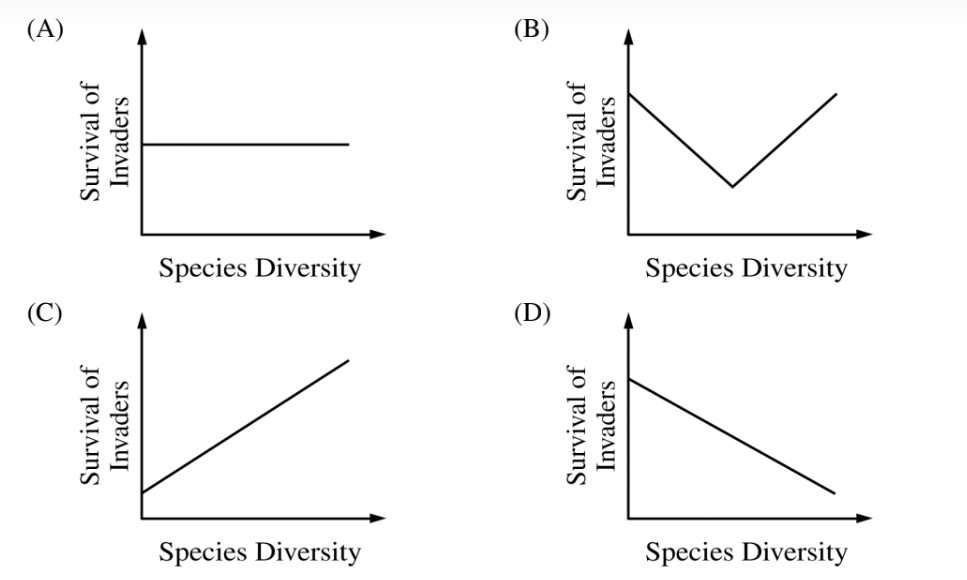Question
Tidal marshland A, which is adjacent to the San Francisco airport, has a Simpson’s Diversity Index of 0.65. Tidal marshland B, which is two
miles from the airport, has a Simpson’s Diversity Index of 0.80. An oil spill occurs at a location at the halfway point between the two
marshlands.
If both marshlands are equally contaminated by the oil spill, which marshland is more likely to recover from the oil spill?
(A) Tidal marshland A is more likely to recover, because its lower
Simpson’s Diversity Index means that few species will be
affected.
(B) Tidal marshland B is more likely to recover, because its higher
Simpson’s Diversity Index means it has a wider variety of species
and can better absorb the effects of a disturbance.
(C) Both ecosystems will be equally affected, because they are the
same distance from the oil spill.
(D) Neither ecosystem will be able to recover, because oil is toxic to
all organisms.
▶️Answer/Explanation
Ans:
(B) Ecosystems with more biodiversity are more likely to be able to
recover from ecological disturbances. Choice (A) is incorrect because a
lower Simpson’s Diversity Index means less biodiversity and that
ecosystem would be less likely to recover from a disturbance. The
difference in the two marshlands’ biodiversity will result in different
abilities to recover from the disturbance, so choice (C) is incorrect. Choice (D) is incorrect because while oil is toxic to all organisms,
some organisms may be able to recover from exposure to oil.
Question
The Nile perch is a species of fish that was introduced into Lake Victoria in the 1950s. It has caused the extinction or near-extinction
of several hundred native species in the lake. Which of the following is an accurate statement regarding the introduction of the perch to
Lake Victoria?
(A) Eutrophication of a lake can decrease its carrying capacity.
(B) Humans can negatively impact the balance of an ecosystem.
(C) The Nile perch is a successful predator.
(D) The diversity in Lake Victoria is likely to increase because most
extinction events are followed by a large increase in
diversification.
▶️Answer/Explanation
Ans: B
Disruptions to ecosystems impact the dynamic homeostasis
(balance) of the ecosystem. In this particular case, humans caused the
disruption by introducing the perch.
Eutrophication (or hypertrophication) is the enrichment (or over-
enrichment) of water by nutrients. It results in excessive bacterial and/or
algae growth, often called “blooms.” When these organisms die, the
oxidative breakdown of the detritus leads to an oxygen shortage (see answer
114). There is no indication that the extinction of other fish was due to
predation. True, Nile perch are predators. But similar disruption to an
ecosystem could be caused by a primary consumer (herbivore) that
outcompetes native species. Although the mass extinctions on Earth have
been succeeded by diversifications, a local extinction event is not
necessarily followed by a diversification.
Question.
Which of the following best explains why many different species can live together within an ecosystem with limited resources?
(A) Each species lives in a slightly different habitat.
(B) Each species occupies a different niche.
(C) Each species inhabits a different biome.
(D) Each species makes up a different population.
(E) Each species functions at a different trophic level.
▶️Answer/Explanation
Ans:B
Question
A researcher is investigating the relationship between the existing species diversity in a community and the ability of an introduced nonnative species to destabilize the community. Which of the following graphs is most consistent with the claim that communities with high diversity are more resistant to change than are communities with low diversity?

▶️Answer/Explanation
Ans:D
Question
Which of the following habitats contain the most bryophytes?
(A) Deciduous forests
(B) Deserts
(C) Ponds
(D) Oceans
(E) Grassland
▶️Answer/Explanation
:A
